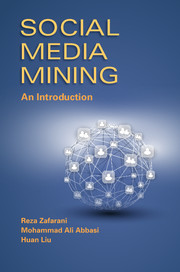10 - Behavior Analytics
from Part III - Applications
Published online by Cambridge University Press: 05 July 2014
Summary
What motivates individuals to join an online group? When individuals abandon social media sites, where do they migrate to? Can we predict box office revenues for movies from tweets posted by individuals? These questions are a few of many whose answers require us to analyze or predict behaviors on social media.
Individuals exhibit different behaviors in social media: as individuals or as part of a broader collective behavior. When discussing individual behavior, our focus is on one individual. Collective behavior emerges when a population of individuals behave in a similar way with or without coordination or planning.
In this chapter we provide examples of individual and collective behaviors and elaborate techniques used to analyze, model, and predict these behaviors.
Individual Behavior
We read online news; comment on posts, blogs, and videos; write reviews for products; post; like; share; tweet; rate; recommend; listen to music; and watch videos, among many other daily behaviors that we exhibit on social media. What are the types of individual behavior that leave a trace on social media?
We can generally categorize individual online behavior into three categories (shown in Figure 10.1):
1.User-User Behavior. This is the behavior individuals exhibit with respect to other individuals. For instance, when befriending someone, sending a message to another individual, playing games, following, inviting, blocking, subscribing, or chatting, we are demonstrating a user-user behavior.
Information
- Type
- Chapter
- Information
- Social Media MiningAn Introduction, pp. 271 - 294Publisher: Cambridge University PressPrint publication year: 2014
